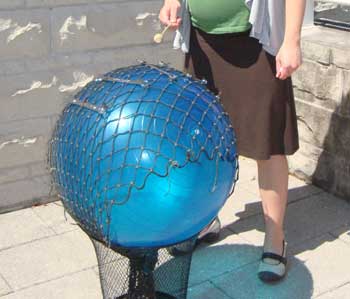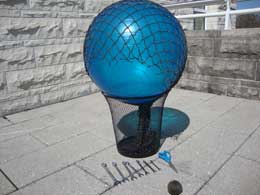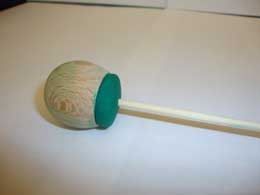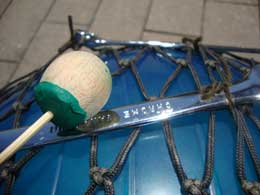Physics in the Tool Shed: Toolaballoonaphone

Take an exercise ball, some fish net and some old wrenches and presto! You’ve got a music machine.
What you Need
Toolaballoonaphone
- An exercise ball
- A fish net (Available from most party stores)
- A set of wrenches of various sizes
- String
- A scissors
- A clean waste basket
The Mallet
- A kebob skewer
- Clay
- Wooden bead or Cholula hot sauce bottle cap
What to Do
Making the Toolaballoonaphone
- Put the exercise ball on top of the opening to the waste basket. Then drape the fish net over the ball.

- Gather the excess net at the bottom of the ball and then flip the ball over and tie the excess net in a knot.

- Turn the ball over so the excess net hangs down into the waste basket.

- Attach wrenches with string to the net. Then cut off the excess string.

- Presto! You have made your own Toolaballoonaphone. Now you need to make a mallet to play it.

Making the Mallet
- Pack the clay inside the wooden bead or wooden Cholula hot sauce cap.

- Stick the kabob skewer into the clay.

What’s Going On?
To understand the physics behind this unconventional instrument; first, you need to ask yourself, “What is inside the exercise ball?” If you answered, “air,” then you are correct. Air is a really important part of the physics of sound. Sound waves need to travel through something. If you knock on a door, the waves travel through the wood, if you scream, the sound waves travel through the air.
Sound waves are compression waves. Compressions waves are made when something is compressed and then relaxed. Sound is made when something vibrates (moves back and forth really quickly). In the case of a scream, your vocal cords are vibrating. When something vibrates in the air, it pushes the air particles around it at the same rhythm as the vibration. This rhythm is called the frequency, which is how often the object making the sound moves back and forth. The air vibrating makes our eardrums vibrate and our brain interprets this as a sound. The sound or tone changes in response to a change in frequency. When something vibrates quickly, it will have a higher frequency and create a higher tone than something that vibrates more slowly. This is how different notes are made.
When you hit the tools on the toolaballonaphone with the mallet they vibrate, creating compression waves. The longer tools vibrate slower and create a lower note than the shorter tools. What makes the toolaballoonaphone special is that when the tool vibrates the air particles inside the ball become compression waves, but instead of floating through the air, they are able to bounce off the walls inside the ball. When the waves bounce off the walls of the ball it amplifies the sound created by the tools vibration, which is a fancy way of saying it makes the sound louder.
Try This!
- Try putting different pieces of metal on your toolaballoonaphone. What tones can you make?
- Try putting the tools in order of frequency and see if you can play a song.
More Information











